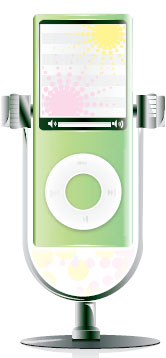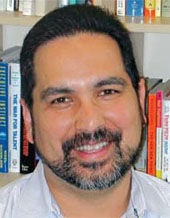- iPod Culture Displays Some Leading Indicators For Future AV Design
- Earlier this year a “flash mob” trend crossed the Atlantic and landed in New York. A flash mob is a group of people who assemble suddenly in a public place (enabled by social networking), perform an unusual action for a short time and then disperse. This flash mob event was called a Silent Rave. It involved people gathering in New York City’s Union Square and dancing to the sound of their own individual MP3
players. Onlookers saw only people dancing in silence.
The spectacle of this event does not interest me as much as how this phenomenon might inform us about sound and physical space. This impromptu “club” had an aural environment for each participant of his or her own design. No one was employed to plan this space, create an acceptable acoustical environment, and install a sound system. All of that existed literally in the hands of the dancers.
Creating virtual space with headphones is also on the mind of Apple. This year Apple published a patent titled “Audio Processing for Improved User Experience,” detailing new audio concepts for the iPhone. The patent describes the idea of binaurally distinguishing the position of different participants in a multiparty call. Directional audio processing would be used so that the “different sources of audio for the call can be directionally placed in a particular location with respect to the headset. As a result, the user of the device hears the other participants in the multi-party call as sound sources originating from different locations.” Although the patent goes on to describe the interface that would allow the listener to “position” the distant callers manually, there may be ways to do this automatically.
My new cell phone has GPS, just like my last one, which means I’ve been living with a GPS-enabled phone now for more than a year. So far, though, this hasn’t been of much benefit. I can find my location and get directions on a tiny map and I can find things of interest to me near where I am. Much more interesting, though, is the work being done by artists who have been experimenting with what is known as “locative media.”

iPod/iPhone. Apple has applied for a patent titled “Presentation of Audible Media in Accommodation with External Sound.” This patent would allow iPods to actively blend external sounds such as traffic or people talking nearby with whatever might be playing at the time. The patent simply describes the integration of a microphone into the iPod and the ability to blend what is being picked up by that microphone into the music.
And what is an iPod with a microphone? How will the iPhone (and similar products that merge media and the cell phone) change AV systems as we know them? Today iPod/iPhone headphones are used to isolate people. Michael Bull wrote in Sound Moves: iPod Culture and Urban Experience that people use iPods to transform their offices “into an auditory and hermetically sealed space for (their) own work and thoughts.” However if the potentially ubiquitous iPhone were to integrate the spatial and audioblending technologies described above, architectural spaces could be transformed by our mobile devices. AV spaces may be supplemented or supplanted by portable media. Perhaps the office spaces that were to be transformed or even destroyed by telecommuting in the 1990s, will finally be altered by the devices that commute along with us. In the future you may have a conference room in your pocket.
David Person of Person Consulting contributed to the Apple patent research for this article.
